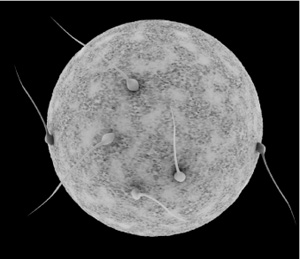Biology and YouYou and Your Body |
What is parthenogenesis? |
In a process called parthenogenesis in animals, an organism’s egg cell can develop into an embryo without being fertilized (it occurs more often in plants). This type of fertilization most often occurs in invertebrates, such as flatworms, aphids, and nematodes; in a few vertebrates, such as whiptail lizards and some fish (reportedly once, a hammerhead shark); and even rarely in some birds, such as chickens and turkeys. (For more about animal reproduction, see the chapter “Physiology: Animal Function and Reproduction.”)

Sperm cells work to fertilize a human egg. Only one of them (usually), manages to enter the egg, combining the DNA of the male and female parents.
